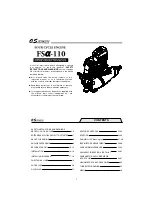
See chapter Exhaust gas & charge air systems for more information.
4.2.12
Fuel injection equipment
The fuel injection equipment and system piping are located in a hotbox, providing maximum
reliability and safety when using preheated heavy fuels. In the Wärtsilä electronic fuel injection
system, the fuel is pressurized in the high pressure HP-pumps from where the fuel is fed to
the injection valves which are rate optimized. The fuel system consists of different numbers
of fuel oil HP pumps, depending of the cylinder configuration. HP pumps are located at the
engine pump cover and from there high pressure pipes are connected to the system piping.
A valve block is mounted at the fuel outlet pipe, including Pressure Drop and Safety Valve
(PDSV), Circulation Valve (CV) and a fuel pressure discharge volume. The PDSV acts as
mechanical safety valve and the fuel volume lowers the system pressure. The injection valves
are electronic controlled and the injection timing is pre-set in the control system software.
When operating the engine in gas mode, the gas is injected through gas admission valves into
the inlet channel of each cylinder. The gas is mixed with the combustion air immediately
upstream of the inlet valve in the cylinder head and the gas/air mixture will flow into the cylinder
during the intake stroke. Since the gas valve is timed independently of the inlet valve,
scavenging of the cylinder is possible without risk that unburned gas is escaping directly from
the inlet to the exhaust. The compressed gas/air mixture is ignited with a small amount of
diesel fuel (pilot injection) which is integrated to the main fuel injection system and is also
electronically controlled.
4.2.13
Lubricating oil system
The engine internal lubricating oil system include the engine driven lubricating oil pump, the
electrically driven prelubricating oil pump, thermostatic valve, filters and lubricating oil cooler.
The lubricating oil pumps are located in the free end of the engine, while the automatic filter,
cooler and thermostatic valve are integrated into one module.
4.2.14
Cooling water system
The fresh water cooling system is divided into a high temperature (HT) and a low temperature
(LT) circuit.
For engines operating in normal conditions the HT-water is cooling the cylinders (jacket) and
the first stage of the low pressure 2-stage charge air cooler. The LT-water is cooling the
lubricating oil cooler, the second stage of the low pressure 2-stage charge air cooler and the
high pressure 1-stage charge air cooler.
For engines operating in cold conditions the HT-water is cooling the cylinders (Jacket). A
HT-water pump is circulating the cooling water in the circuit and a thermostatic valve mounted
in the internal cooling water system, controls the outlet temperature of the circuit. The LT-circuit
is cooling the Lubricating Oil Cooler (LOC), the second stage of the Low Pressure 2-stage
charge air cooler, the High Pressure 1-stage charge air cooler and the first stage of the low
pressure 2-stage charge air cooler. An LT-thermostatic valve mounted in the external cooling
water system, controls the inlet temperature to the engine for achieving correct receiver
temperature.
4.2.15
Exhaust pipes
The exhaust manifold pipes are made of special heat resistant nodular cast iron alloy.
The complete exhaust gas system is enclosed in an insulating box consisting of easily
removable panels. Mineral wool is used as insulating material.
4.2.16
Automation system
The Wärtsilä 31 engine is equipped with an UNIC electronic control system. UNIC have
hardwired interface for control functions and a bus communication interface for alarm and
4-4
DBAE248994
Wärtsilä 31DF Product Guide
4. Description of the Engine
Summary of Contents for ?31DF Series
Page 1: ...PRODUCT GUIDE W rtsil 31DF...
Page 4: ...This page intentionally left blank...
Page 8: ...This page intentionally left blank...
Page 14: ...This page intentionally left blank...
Page 74: ...This page intentionally left blank...
Page 84: ...This page intentionally left blank...
Page 134: ...This page intentionally left blank...
Page 150: ...This page intentionally left blank...
Page 154: ...This page intentionally left blank...
Page 164: ...This page intentionally left blank...
Page 182: ...This page intentionally left blank...
Page 188: ...This page intentionally left blank...
Page 196: ...This page intentionally left blank...
Page 204: ...This page intentionally left blank...
Page 210: ...This page intentionally left blank...
Page 212: ...This page intentionally left blank...
Page 215: ......
















































